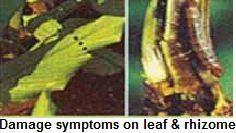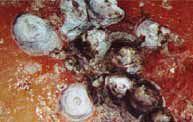Turmeric: Insect and Nematode Pests Management
Turmeric: Insect and Nematode Pests Management
Shoot borer
The pest population is higher in the field during September-October. The pest is most active from July to October.
Biology Egg: Eggs are pink, oval, flat laid singly or in group on leaves and other soft and the tender part of the plant. The eggs hatch in about a week.
Egg: Eggs are pink, oval, flat laid singly or in group on leaves and other soft and the tender part of the plant. The eggs hatch in about a week.- Larva: The larvae pass through 4–5 in stars and are full-fledged in 2–3 weeks. Fully grown larvae are light brown with sparse hairs.
- Pupa: Pupation takes place inside the seed or sometimes in the grass that collects after feeding. Pupation takes place in lose silken coccon in larval tunnel. The pupal stage lasts about one week.
- Adult: It is a medium sized moth with a wingspan of about 20 mm; the wings are orange-yellow with minute black spots.
The life cycle is completed in 4– 5 weeks and three generations are completed in a year.
Favourable conditions- Temperature range 30 - 33 °C and relative humidity range 60 - 90%.
- The larvae bore into pseudostems and feed on internal tissues resulting in yellowing and drying of leaves of infested pseudostems.
- The presence of a bore-hole on the pseudostem through which frass is extruded and the withered and yellow central shoot is a characteristic symptom of pest infestation.
Rhizome scale
- Occurrence: The rhizome scale infests rhizomes in the field (at later stages) and in storage.
- Female: scales are circular (about 1mm diameter) and light brown to gray and appear as encrustations on the rhizomes.
- Male: Male is orange coloured with transparent wings, distinct head, thorax and abdomen
 Adult (female) scales feed on sap and when the rhizomes are severely infested, they become shriveled and desiccated affecting its germination.
Adult (female) scales feed on sap and when the rhizomes are severely infested, they become shriveled and desiccated affecting its germination.- In initial stage of infestation, the white coloured scales are seen scattered on rhizomes and later they congregate near the growing buds.
- When the infestation is severe the rhizome and buds shrivel and ultimately the entire rhizome dries.
Thrips
Biology- Egg: Thrips reproduce by laying eggs.
- Nymph: Nymphs emerge from the eggs. It takes between 7 and 12 days to develop from eggs into adult thrips.
- Adult: Thrips are very small, have elongated abdomens and are yellowish or blackish in color. Although the adults have wings, these insect pests do not usually fly. They are often found on plants throughout all growth stages, from sprout development to tuber maturation.
- Warm and humid weather
- Thrips damage the undersides of leaves by sucking their plant sap.
- They damage young and soft parts of plants such as new leaves and shoots.
- Leaves become rolled up, and turn pale and gradually dry-up
- Severe infestation causes young leaves to wilt and dry out.
Bihar hairy caterpillar
Biology- Egg: Eggs are light green spherical in clusters on the underside of leaves. The eggs hatch after about 6-9 days.
- Larva: The larvae are covered with long yellowish to black hairs and are up to 5 cm long. Larval stages lasted within 34-45 days.
- Pupa: The pupa forms a thin silken cocoon by interwoven shed hairs of the larvae. Pupal stages lasted within 16- 22 days. Pupation takes place in the soil under dry foliage and debris where the pupae over wintering.
- Adult: Bihar hairy caterpillar moth is brown with a 40-50 mm wing span and a red abdomen. Female lays 533- 1287 eggs. A total life cycle is of 59-76 days.
- Young larvae feed gregariously on the under surface of the leaves and cause loss by way of defoliation.
- Sometimes, after defoliated the crop larvae feed on the capsules.
- In severe cases only stems are left behind.
- They also severely damage other oilseeds such as sunflower.
Lacewing bug
- Small, whitish lacewing bug found in colonies on the foliage, causing a sickly and spotted appearance of the plant. The pest infestation is more common during the post monsoon period especially in drier regions of the country
- The foliage of infested plants turns pale or yellow and dries up.
Leaf roller/skipper
Biology- Egg: Pinkish oval flat eggs are laid singly or in groups or 2 or 3 on leaves. The egg, period last for 3-4 days.
- Larva: There are five larval instars, fully grown larvae are dark green with black head and constricted neck. The pest is abundant in the field during August - October. The larval period last for 12-21 days
- Pupa: Pupation takes place on the same plant within a cell. The pupa is long and cylindrical, watery green in colour. It has a long conical projection in front of the head. The most striking characteristic of the pupa is its proboscis. The pupal period last for 6-7 days
- Adult: Adults are medium sized with brownish black wings with eight white spots on forewings and one large patch on hind wing.
- Temperature 26- 35° C, relative humidity 41 - 100%
- The larvae cut and fold the leaves, remain within and feed on them, pupate inside the leaf.
White grubs
Biology- Egg: The females lay eggs singly on the main stem. The eggs are white, almost round in shape
- Larva: The larvae are C shaped, slow movers having globular head and elongated, dorsoventrally flattened body. The young grubs are translucent, white and 5 mm long
- Pupa: Population takes place in the larval tunnel.
- Adult: Adults of Holotrichia spp. are about 18-20 mm long and 7-9 mm wide.
- Grubs are polyphagous and both adults and larvae are damaging stages.
- The grubs live in soil and remain active, feed on the functional roots of the plant, leaving behind only tap root.
- They also burrow into the pseudostem, close to the soil surface and kill the plant.
- Grub infested plants turn pale, leaves and branches drop down, the plant withers and can be easily uprooted.
- It ultimately dies off resulting in patchy crop growth.
- Root grubs occasionally feed on tender rhizomes, roots and base of pseudostems causing yellowing and wilting of shoots.
- Warm and humid weather
Root knot, burrowing and lesion nematodes
Damage symptoms- Root-knot nematode feed on tender rhizomes, roots and base of pseudostem causing stunting, chlorosis, poor tillering and necrosis of leaves are the common aerial symptoms.
- Characteristic root galls and lesions that lead to rotting are generally seen in roots.
- The infested rhizomes have brown, water soaked areas in the outer tissues.
- Nematode infestation aggravates rhizome rot disease

- Nematodes survive in soil and infected rhizomes as primary inoculum.
- Therefore, tissues from infected crops remaining in the fi eld serve as a reservoir of the fungus.
- It spreads from infected plants or through soil.
- Warm, moist soil are favourable conditions
IPM for Turmeric
To know the IPM practices for Turmeric, click here.
Source: NIPHM and Directorate of Plant Protection, Quarantine & Storage
Last Modified : 3/31/2020
© C–DAC.All content appearing on the vikaspedia portal is through collaborative effort of vikaspedia and its partners.We encourage you to use and share the content in a respectful and fair manner. Please leave all source links intact and adhere to applicable copyright and intellectual property guidelines and laws.
RELATED ITEMS
Fenugreek Insect Pests
This topic covers information about Fenugreek Ins...
Cherry Insect Pests
This topic provides information about Cherry- Inse...
Betelvine Insect Pests
This topic covers information about Description of...
Chilli insect pests
This topic covers information about Chilli insect...
